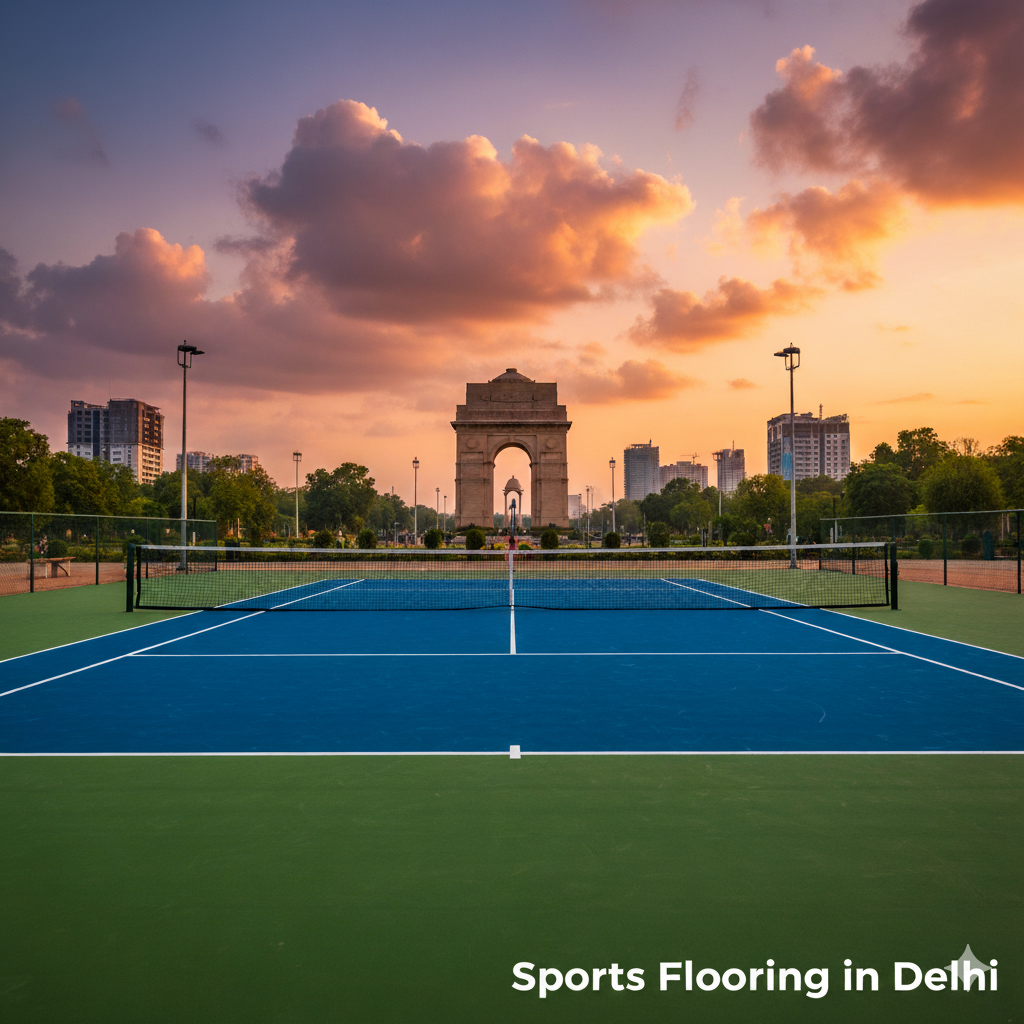
The capital city of India, Delhi, isn’t just a political and cultural hub—it’s a thriving nerve center for athletics and fitness. From elite sports academies and municipal parks to high-end residential complexes and personal backyard courts, the demand for dedicated sports facilities is booming. But creating a world-class court requires more than just marking lines on concrete; it requires a specialized, high-performance foundation, and choosing the right Sports Flooring in Delhi is the crucial first step.
The Delhi-NCR climate presents a unique and demanding set of challenges. Extreme summer heat pushes material durability to its limits, monsoon rains test drainage, and winter temperatures demand surfaces that won’t crack or degrade. Choosing the wrong flooring here can lead to rapid deterioration, costly maintenance, and, critically, increased risk of athlete injury.
This is where the choice of surface becomes paramount. This guide is designed for facility managers, builders, and homeowners in Delhi, Gurugram, and Noida who are ready to invest in quality. We will break down the ideal sports flooring solutions built specifically to conquer the Delhi environment while delivering unmatched performance and safety. As a trusted leader in premium synthetic sports surfaces, AAL is here to ensure your court is built for champions, built for durability, and built for Delhi.
Why Standard Flooring Fails in Delhi
When planning a new court, many facility owners initially consider simple concrete or asphalt—the cheapest standard flooring options. However, in a demanding metropolitan area like Delhi-NCR, these materials fail quickly, leading to constant maintenance costs and, more importantly, compromising the safety and performance of the athletes.
The Problem with Concrete and Traditional Surfaces
1. Extreme Temperature Fluctuations (The Heat & Cold Cycle)
- Summer Heat Impact: Delhi’s summers regularly push temperatures past Concrete and untreated asphalt absorb this intense heat, becoming extremely hot to the touch and accelerating material fatigue. This intense heat causes standard surfaces to expand rapidly.
- Winter Degradation: Conversely, the sharp drop in winter temperatures causes the material to contract. This constant cycle of expansion and contraction leads to cracking, crazing, and structural failure of the base layer, creating dangerous trip hazards.
2. Water Damage, Humidity, and Poor Drainage
- Monsoon Vulnerability: While synthetic acrylic surfaces are non-porous and shed water, standard concrete is prone to pooling. If water seeps beneath the concrete (a common issue with minor cracks), it causes sub-surface erosion and leads to larger cracks and eventual surface breakdown.3
- Slippery Hazards: Untreated concrete and asphalt become incredibly slick when damp or dusty. This creates a high risk of slips, falls, and impact injuries, especially during dynamic sports like basketball or tennis.
3. Lack of Shock Absorption and Increased Injury Risk
- Athlete Fatigue: Hard, unforgiving surfaces offer zero shock absorption. This forces an athlete’s joints—ankles, knees, and hips—to absorb 100% of the impact from running, jumping, and pivoting.
- Performance Killer: Over time, playing on these surfaces leads to accelerated muscle fatigue, shin splints, and chronic joint issues, effectively shortening an athlete’s career or enjoyment of the sport.
The long-term solution is a material specifically engineered to be elastic, UV-stable, and durable enough to handle Delhi’s environmental extremes while prioritizing athlete protection.
Top Sports Court Flooring Options for Delhi

To meet the high standards of performance and climate resilience required in Delhi-NCR, specialized synthetic surfaces are the only reliable choice. These materials are engineered to be UV-stable, shock-absorbent, and flexible enough to handle the region’s extreme weather cycle.
Synthetic Acrylic Flooring (Ideal for Tennis, Basketball & Pickleball)
Acrylic is the premier choice for outdoor courts and forms the core of Arcylic Coat‘s high-performance system. This multi-layered coating is applied over a stable asphalt or concrete base, creating a seamless, vibrant playing surface.
- Delhi Suitability: Acrylic is highly resistant to both extreme UV radiation (preventing color fade and cracking in summer) and moisture damage.
- Performance: It provides excellent rotational grip for quick pivots and a perfectly consistent ball bounce, making it the surface of choice for competitive tennis and basketball.
- PaceCourt Advantage: We offer options that are ITF Classified (International Tennis Federation), ensuring your facility meets global professional standards. Our system includes a flexible Color Coat layer that maintains its aesthetic appeal despite the dust and pollution common in Delhi.
Modular/Polypropylene (PP) Interlocking Tiles (Great for Quick Installation & Home Use)
PP interlocking tiles are a versatile, low-maintenance solution made of durable, high-impact plastic. These tiles snap together over any hard surface, creating a floating floor.
- Delhi Suitability: Their design allows for rapid, 100% water drainage, meaning courts are ready to play almost immediately after a monsoon shower—a massive advantage in the rainy season.
- Performance: The tiles provide a slight cushioning effect and are less abrasive than raw concrete.
- Delhi Relevance: They are often the best choice for small spaces, like residential rooftop or terrace courts and high-use school multi-purpose areas, due to their ease of installation and ability to be removed if needed.
EPDM/PU Rubberized Surfaces (Best for Tracks & Multi-Purpose Halls)
These surfaces utilize a mix of granulated rubber (EPDM) or high-grade polyurethane (PU) to create a thick, seamless, cushiony layer.
- Delhi Suitability: The cushion coat provides a durable, soft surface that greatly minimizes the impact of dust and debris abrasion.
- Performance: The superior shock absorption of rubber is critical for injury prevention. This is non-negotiable for running, jogging, and intense group exercise.
- Primary Use: These surfaces are the standard for walking tracks in parks and colonies (where comfort is key), as well as multi-purpose indoor gymnasiums and volleyball courts where players frequently jump and fall.
By selecting one of these specialized synthetic systems, you are choosing a surface that actively protects athletes while providing long-term value against the harsh realities of the Delhi environment.
Key Factors When Choosing a Supplier in Delhi

Choosing the right material is only half the battle; the long-term success of your court hinges on selecting a supplier and installer who understands both the product and the specific conditions in Delhi.
Certification and Quality (The Trust Factor)
In the competitive Delhi market, many suppliers offer low-cost materials that do not meet professional standards. To protect your investment and your athletes, look for verifiable credentials:
- Global Certification: Demand materials that adhere to international benchmarks. For tennis courts, this means ITF (International Tennis Federation) Classification. For multi-sport flooring, look for compliance with relevant national or international sports body specifications. This ensures the surface provides the right grip, shock absorption, and ball bounce.
- Proof of Quality: A reliable supplier should provide case studies, high-resolution portfolio images, and testimonials from schools or clubs specifically in the Delhi/NCR region.
Climate Suitability & Warranty (Long-Term Value)
Your court is exposed to a brutal annual cycle—scorching sun, heavy monsoon, and winter chill. Your supplier must account for this:
- UV and Weather Resistance: Ensure the materials are explicitly UV-resistant to prevent fading and cracking under the harsh summer sun. The formulation must be flexible enough to handle the thermal expansion and contraction common in Delhi.
- The Warranty: A supplier confident in their materials will offer a substantial warranty. PaceCourt, for instance, offers a 3-Year Warranty on materials, demonstrating confidence in their longevity and durability against regional weather. This warranty is your assurance of long-term reliability.
Installation Expertise (The Foundation of Durability)
Even the best material will fail if improperly installed. Installation is a specialized skill that must be handled by professionals experienced in synthetic systems.
- Subfloor Mastery: The most common point of failure is improper preparation of the concrete or asphalt base. Your supplier must demonstrate expertise in moisture mitigation, crack filling, and ensuring the subfloor is perfectly clean and level before coating begins.
- Precision Layering: The synthetic system (primer, cushion, color coat) involves multiple, precisely timed applications. A top-tier Delhi supplier will have a dedicated team that understands the ambient temperature and humidity required for optimal curing and seamless application, ensuring a uniform and durable finish across the entire court.
Installation Process Snapshot
The application of high-performance sports flooring is a precise, multi-step process that guarantees the longevity and integrity of the court. When working with a professional supplier like PaceCourt, the installation follows a rigorous standard designed to prevent the common failures associated with DIY or shortcuts.
Here is a typical four-step overview of the installation process for a synthetic acrylic sports court:
Step 1: Consultation and Site Assessment
- The process begins with an expert evaluation of your specific Delhi/NCR site. We assess the existing subfloor (concrete or asphalt), check for moisture levels, and determine the exact requirements for drainage and crack repair.
- This stage is crucial for ensuring the foundation is structurally sound before any material is applied.
Step 2: Base Preparation and Resurfacing
- Cleaning & Priming: The existing surface is thoroughly cleaned and primed. A specialized acrylic primer is applied to ensure maximum adhesion between the existing subfloor and the new synthetic system.
- Leveling: An acrylic resurfacer is applied. This dense material fills minor cracks, pores, and surface imperfections, creating a perfectly smooth, level canvas. This is a non-negotiable step for long-term durability.
Step 3: Coating Application (Cushion and Color)
- Cushion Layer (Optional but Recommended): For maximum athlete comfort and injury prevention, a rubber-granule Cushion Coat is applied. This layer absorbs vertical impact, reducing stress on joints.
- Color Coat: The final layers of UV-stable Color Coat (in your chosen vibrant colors) are applied. This is done with precision tools to ensure a uniform texture and consistent playing speed across the entire surface.
Step 4: Professional Line Marking and Curing
- Line Marking: Using specialized templates and measuring equipment, bright, durable acrylic Line Marking paint is applied with razor-sharp precision according to the exact dimensions of the sport (e.g., ITF standards for tennis or official specifications for pickleball).
- Curing: The final surface is allowed to cure completely. This period is vital—rushing the curing process can lead to bubbling or peeling. Once cured, your court is officially ready for high-performance use!
Conclusion
The decision to install or resurface a sports court in the Delhi-NCR region is a major one—it is an investment not only in real estate but in athletic excellence, injury prevention, and community health.
As we have seen, the unique climate demands that you move beyond standard materials. By choosing Synthetic Acrylic, Modular Tiles, or Rubberized Surfaces, and by insisting on ITF Certification, a strong warranty, and expert local installation, you safeguard your facility against the region’s extreme heat, rain, and dust. The longevity and safety provided by a professionally built court will always deliver a far superior return on investment than the short-term savings offered by cheaper, inadequate materials.
FAQ
Synthetic acrylic sports flooring is a multi-layered system applied over a concrete or asphalt base. It is a premium, specialized coating (made of acrylic resin and often rubber granules) engineered to provide specific levels of grip, shock absorption, and weather resistance for outdoor courts (tennis, pickleball, basketball).
Our synthetic acrylic surfaces are designed for extreme durability. With proper installation and routine maintenance, they typically last 8 to 10 years before requiring resurfacing. We back our quality with a 3-Year Warranty on materials.
Yes. We offer cushioned systems that incorporate a rubber underlay (Cushion Coat) to absorb impact. This significantly reduces stress on athletes’ joints, mitigating fatigue and lowering the risk of impact-related injuries compared to hard concrete.
Yes, our high-performance tennis court surfaces are certified and classified by the ITF (International Tennis Federation), ensuring they meet global standards for ball bounce and playing speed.
